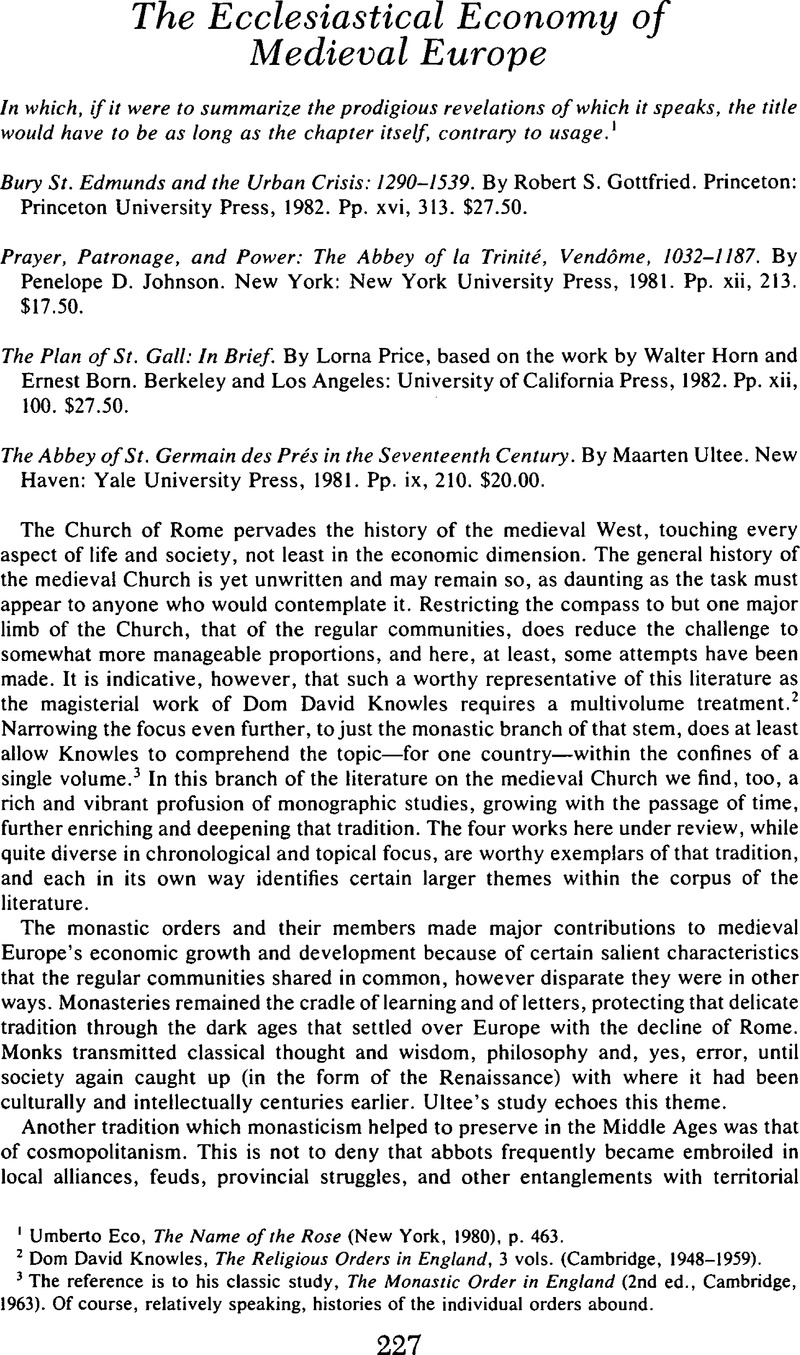Article contents
The Ecclesiastical Economy of Medieval Europe
Published online by Cambridge University Press: 03 March 2009
Abstract

- Type
- Review Article
- Information
- Copyright
- Copyright © The Economic History Association 1986
References
1 Eco, Umberto, The Name of the Rose (New York, 1980), p. 463.Google Scholar
2 Knowles, Dom David, The Religious Orders in England, 3 vols. (Cambridge, 1948–1959).Google Scholar
3 The reference is to his classic study, The Monastic Order in England (2nd ed., Cambridge, 1963). Of course, relatively speaking, histories of the individual orders abound.Google Scholar
4 Arguably the most significant exception to the rule of monasticism as integrative force occurs with respect to the regional diversity of cuisine; see Root's, Waverly classic The Food of France (New York, 1958), pp. 4–5, passim.Google Scholar
5 See, for example, Estow, Clara, “The Economic Development of the Order of Calatrava, 1158–1366,” Speculum, 57 (1982), pp. 267–91;CrossRefGoogle Scholar and also the interesting piece by Philippe, Robert, “L'Église et l'énergie pendant le Xle siècle dans les pays d'entre Seine et Loire,” Cahiers de civilisation medievale, 27 (1964), pp. 107–17. I am indebted to David S. Landes for the latter reference.CrossRefGoogle Scholar
6 See their earlier The Barns of the Abbey of Beaulieu at its Granges of Great Coxwell and Beaulieu St. Leonards. A Study in Medieval Survivals: Two Cistercian Abbey-Barns in England dating from the First Half of the 13th Century (Berkeley, 1965).Google Scholar
7 The identification of the plan as that of St. Gall owes to the circumstances of its accidental preservation and rediscovery, not from any association between the plan and that monastery's construction.Google Scholar
8 Migne, J. P., ed., Patrologiae Cursus Completus, 97 (Paris, 1962).Google ScholarGuérard, B.E.C., ed., Polyptique de l'abbé Irminon (Paris, 1844).Google Scholar
9 See Finberg, H.P.R., Tavisgock Abbey (Cambridge, 1951);Google ScholarMiller, Edward, The Abbey and Bishopric of Ely (Cambridge, 1951);Google Scholar nd Smith, R.A.L., Canterbury Cathedral Priory (Cambridge, 1943).Google Scholar
10 For another illustration of this relationship, see Mate, Mavis, “The Impact of War on the Economy of Canterbury Cathedral Priory,” Speculum, 57 (1982), pp. 761–78.CrossRefGoogle Scholar
11 See Gottfried's “Introduction” for these and additional references.Google Scholar
12 A similar process is exemplified in the case of St. Gall: see Price, The Plan of St. Gall, p. 84.Google Scholar
13 See Russell, Josiah Cox, Medieval Regions and their Cities (Bloomington, 1972), p. 35, passim, for a discussion of the “poles of growth” function that monasteries, inter alia, could perform.Google Scholar ee also Chapelot, Jean and Fossier, Robert, The Village and House in the Middle Ages (London, 1984);Google Scholar and Webster, Bruce, Scotland from the Eleventh Century to 1603 (Ithaca, N.Y., 1985), pp. 12f.Google Scholar
14 Among the innumerable instances that could be cited, see as illustrative case studies, Constance Berman, Hoffmann, “Land Acquisition and the Use of the Mortgage Contract by the Cistercians of Berdoues,” Speculum, 57 (1982), pp. 250–66;CrossRefGoogle ScholarMannion, Anne M., Novalia. A Study in Cistercian Economic Policy and Practice from 1098–1215 (Ann Arbor, 1982);Google ScholarWilkes, Carl, “Die Zisterzienserabtei Himmerod im 12. und 13. Jahrhundert,” Beiträge zur Geschichte des alten Monchiums und des Benediktinerordens, 12 (Münster, 1924);Google Scholar and Wollenberg, Klaus, Die Entwicklund des Eigenwirtschafr des Zisterzienserklosters Furstenfeld zwischen 1262 und 1632, unter besonderer Berücksichtigung des Auftretens moderner Aspekte (Frankfurt am Main, 1984).Google Scholar
15 I have elsewhere suggested that fifty years or so was fairly typical of the time interval required for this “falling away” process to attain a significant level, if economic practices are a reliable indication (“Plan and Reality in a Medieval Monastic Economy: The Cistercians,” in Adelson, Howard L., ed., Studies in Medieval and Renaissance History, 9[1972], pp. 81–113). My more recent examination of documentary evidence from the abbey of Maulbronn offers additional confirmation of this hypothesis: Hauptstaatsarchiv Stuttgart, A502 PU 146 and A502 1.Google Scholar
16 Dubourg, Dom A., “La vie monastique dans l'abbaye de St. Germain des Prés,” Revue des Questions Historique, 78 (1905), p. 406.Google Scholar
17 See, for example, Thiele, P. Augustinus, “Echternach und Himmerod. Beispiele benediktinischer und zisterziensischer Wirtschaftsfuhrung im 12. und 13. Jahrhundert,” Forschungen zur Sozial- und Wirtschaftsgeschichte (Stuttgart, 1964);Google Scholar and Knowles, M. D., “Cistercians and Cluniacs,” The Historian and Character (Cambridge, 1963), pp. 50–75.Google Scholar
18 See Knowles, M. D., “The Maurists,” Great Historical Enterprises (London, 1963), pp. 34–62.Google Scholar
- 1
- Cited by




